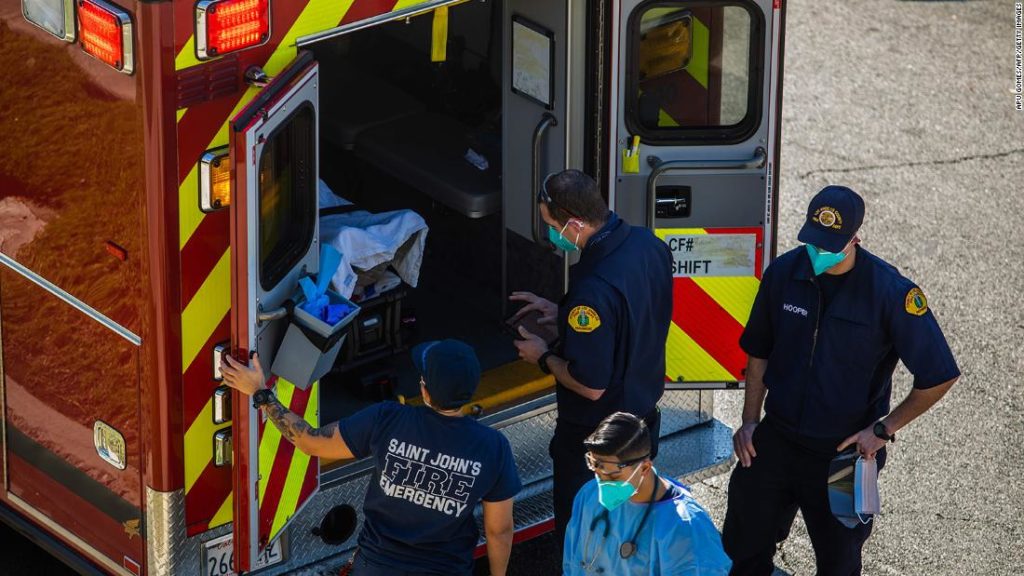Or having a medical emergency and languishing outside an emergency room for hours.
This is what Los Angeles County faces as the onslaught of Covid-19 devastates the community — including those without coronavirus.
And every 15 minutes, one person dies from Covid-19, Los Angeles County Director of Public Health Barbara Ferrer said.
Now, ambulance crews in LA County have been told not to take patients with little chance of survival to hospitals.
“Those patients have a very low rate of survival each if they are transported to the hospital. So at this time, it is deemed to likely be futile.”
Who gets taken to a hospital, and who doesn’t
The Los Angeles County Emergency Medical Services Agency (EMS) issued a memo last week to ambulance workers.
“Effective immediately, due to the severe impact of the Covid-19 pandemic on EMS and 9-1-1 Receiving Hospitals, adult patients (18 years of age or older) in blunt traumatic and nontraumatic out-of-hospital cardiac arrest (OHCA) shall not be transported [if] return of spontaneous circulation (ROSC) is not achieved in the field,” the agency said.
If the patient has no signs of breathing or a pulse, EMS will try to resuscitate the patient for at least 20 minutes, the memo said.
If the patient is stabilized during that time, they would then be taken to a hospital.
But if the patient is declared dead at the scene or no pulse can be restored, paramedics will not take the patient to the hospital.
Patients may or may not get oxygen help
The Covid-19 surge has also led to a shortage of supplemental oxygen, meaning some patients treated by EMS will go without.
“Given the acute need to conserve oxygen, effective immediately, EMS should only administer supplemental oxygen to patients with oxygen saturation below 90%,” Los Angeles County EMS said in its memo.
EMS said an oxygen saturation of at least 90% is sufficient to maintain normal circulation of blood to organs and tissues.
The oxygen shortage in the county and San Joaquin Valley prompted the formation of a “task force on oxygen” last week, Gov. Gavin Newsom said.
The task force has been working with local and state partners to try to refill oxygen tanks and get them to the hospitals and facilities most in need.
Holiday gatherings and essential work fuel Covid-19 spread
As the nation’s most populous state and home to about 1 in 9 Americans, it would make sense that California would have the most Covid-19 cases.
But it’s the magnitude of hospitalized patients and the staggering rate of increase that are causing major problems.
“The increases in cases are likely to continue for weeks to come as a result of holiday and New Year’s Eve parties and returning travelers,” Ferrer said.
“We’re likely to experience the worst conditions in January that we’ve faced the entire pandemic. And that’s hard to imagine.”
Experts say other reasons also contribute — including pandemic fatigue, resistance to stay-at-home regulations, the huge number of essential workers and socioeconomic factors affecting poorer and minority households.
Ambulances wait for hours outside hospitals
Even when patients are lucky enough to get to a hospital, they might languish outside for hours if there’s no more room.
“The Emergency Medical Services are working very hard to divert ambulances or send them to hospitals that do have potential capacity to receive those patients,” said Smith, COO of Cedars-Sinai Medical Center.
“There are situations where patients are made to wait in ambulances under the care of the paramedics. We want to make sure that time is as short as possible so they can receive the necessary care.”
For EMT Jimmy Webb, the wait can last several hours.
“One of our biggest challenges right now is getting our ambulances out of the emergency department,” he said.
“When our paramedics and EMTs transport a patient to an emergency department, there’s a transfer of care that has to take place. Patients who are unstable or unable to be safely transferred to the waiting room or to a chair need a bed in the emergency department to be transferred to. And those beds are lacking right now.”
And more ambulances waiting at hospitals means there are fewer ambulances to respond to other 911 calls — leading to even more delays.
The situation may get worse, Eckstein said.
“I think this next four- to six-week period is going to be critical with our system being taxed,” he said.
CNN’s Jenn Selva and Travis Caldwell contributed to this report.
You may also like
-
UK coronavirus variant has been reported in 86 countries, WHO says
-
NASA technology can help save whale sharks says Australian marine biologist and ECOCEAN founder, Brad Norman
-
California Twentynine Palms: Explosives are missing from the nation’s largest Marine Corps base and an investigation is underway
-
Trump unhappy with his impeachment attorney’s performance, sources say
-
Lunar New Year 2021: Ushering in the Year of the Ox

